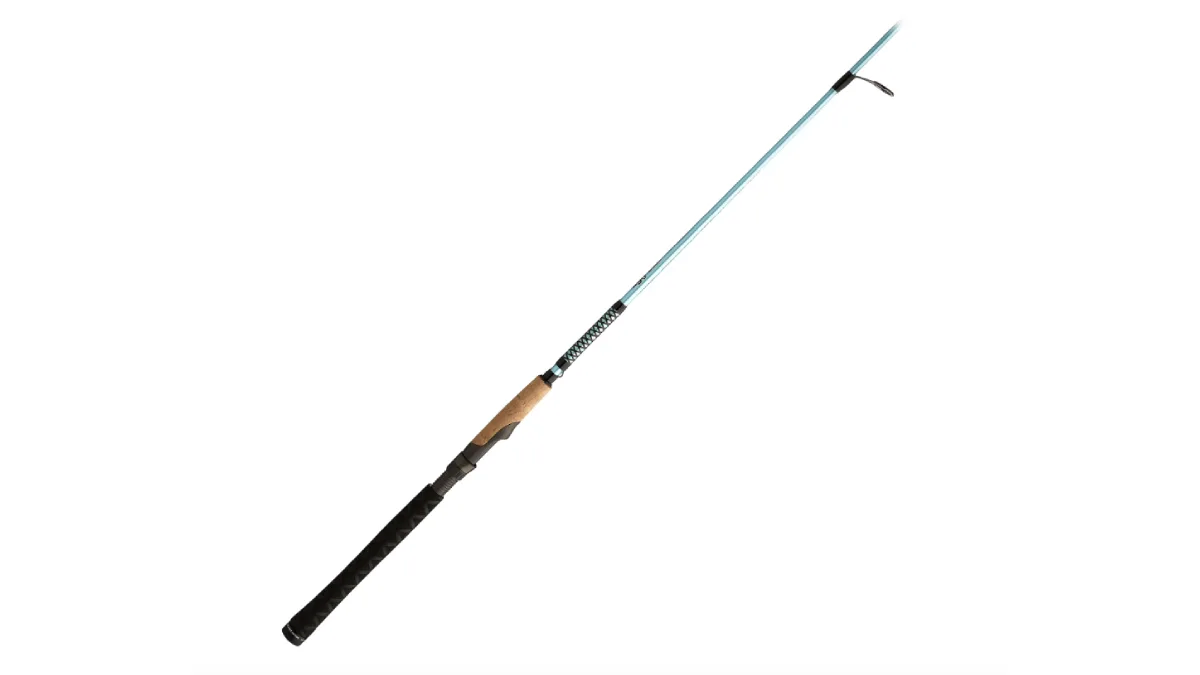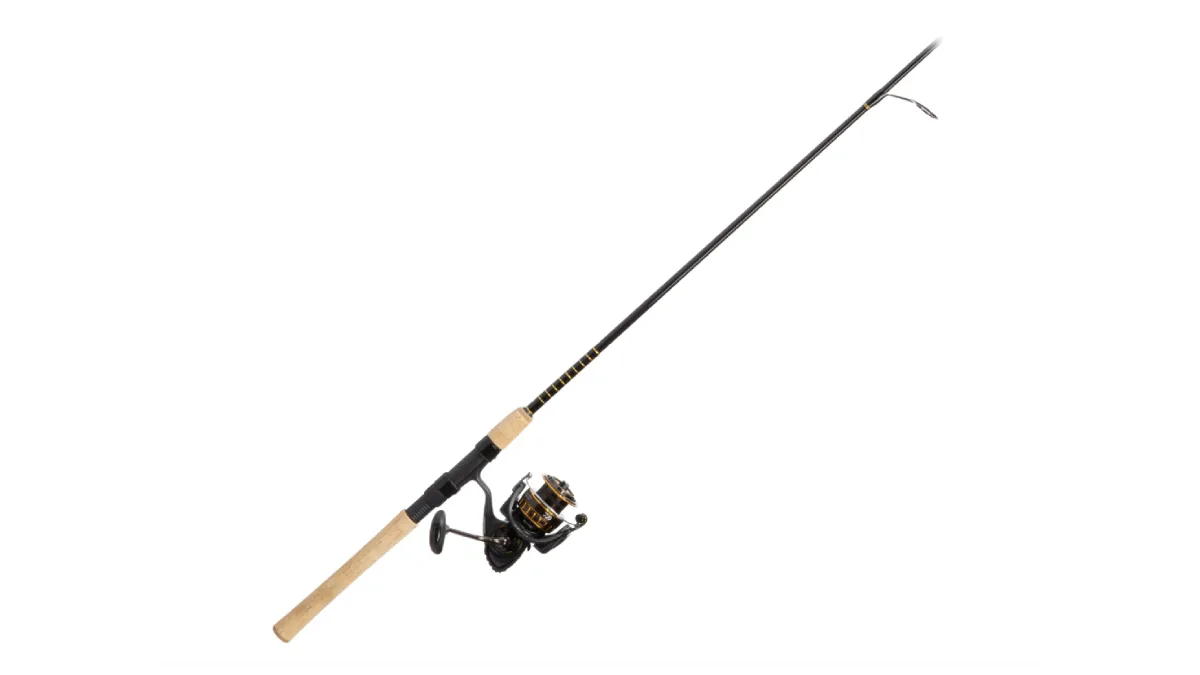The top saltwater rods are built not only to battle the larger fish present in the world’s oceans, but also to resist the highly corrosive effects of exposure to saltwater. Whether you are targeting redfish and snook in the flats, or marlin and tuna far offshore, saltwater fishing rods have a much stricter case use basis than freshwater in most instances. Subsequently, picking the correct rod for the job becomes vital in determining an angler’s success or failure.
With the market completely saturated with a variety of great fishing rods for saltwater, deciding how to spend your hard-earned money can be an understandable challenge—especially for anglers who are just beginning to start their adventures in the ocean. We are here to help with our picks for the best saltwater rods you can buy right now.
Best Rod and Reel Combo: Daiwa BG Saltwater Combo
Best Fly Rod: Sage Salt R8
Best Spinning: Penn Carnage III
Best Jigging: Bubba Tidal Pro Spinning
Best Casting Rod: Fenwick HMG Inshore
Best Inshore: Star Rods Seagis Inshore
Best Offshore: Shimano Terez
Best for the Money: Ugly Stik Carbon Inshore
Best All Around: Penn Ally II Conventional
How We Picked the Best Saltwater Rods
To determine the best saltwater rods, we first leaned heavily on our own experiences on the ocean. Many rods on this list have been thoroughly tested by members of the Field & Stream staff. In some instances, we tested these rods against some of the hardest-fighting game fish on the planet, so we’ve figured out what is going to work in the salt and what won’t. Additionally, we carefully considered several factors for each rod, comparing several key factors on each. Most notably:
Construction: What materials were used for the rod blank? What type of guides and reel seats does the rod have?
Lengths: Are there a variety of lengths to fit multiple scenarios available? Or is this a specialty rod with one specific purpose?
Power: Is this a light rod meant for smaller species in the flats like bonefish? Or is this a heavy option meant for offshore tuna and swordfish?
Action: Is this a fast action rod meant for jigging? Or is this a slow action better suited for live bait or trolling?
Best Saltwater Rods: Reviews and Recommendations
Best Rod and Reel Combo: Daiwa BG Saltwater Combo
Best Rod and Reel Combo
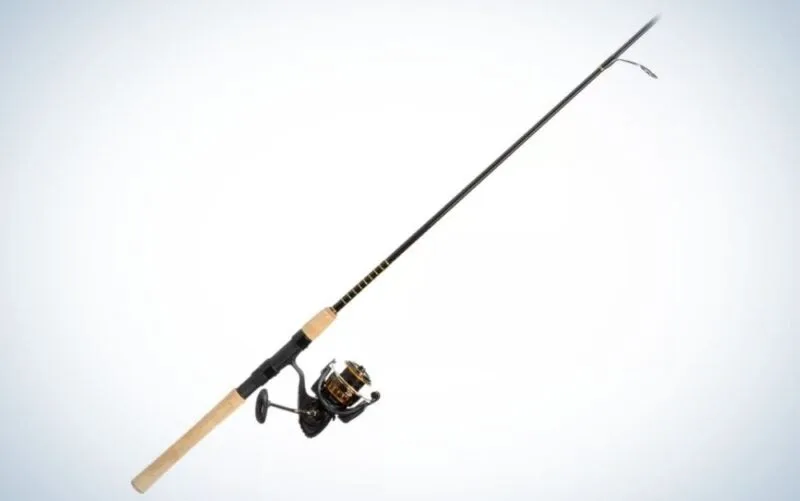
Specs
Lengths: 7’ – 10’
Power: Medium light, Medium, Medium heavy
Construction: Graphite
Action: Fast
Pros
Great price point
Excellent drag system
Sensitive one-piece graphite construction
Cons
Heavier reel
Coming in at $159 on the high end, Daiwa has put together one of the most affordable rod and reel combos on the market that’s perfect for anglers new to saltwater. While it has a budget-friendly price, it also has the sensitivity one would expect in a more expensive rod due to the graphite construction. There are a few different variants of these rods—some feature cork grips and a one-piece construction while others have EVA foam grips and are two-piece. Either way, it’s hard to go wrong for a first-time saltwater rod. Especially since Daiwa throws in an aluminum bodied reel with 6+1 bearing system. It’s a solid saltwater fishing reel that’s perfect for most inshore fishing opportunities.
The only real complaint about this combo is the reel is a little heavier than we’d like. Consequently, some anglers might not find it as comfortable for fishing all day. However, for the price, this is an excellent starting point for newer saltwater anglers who aren’t quite sure what to buy.
Best Fly Rod: Sage Salt R8
Best Fly Rod
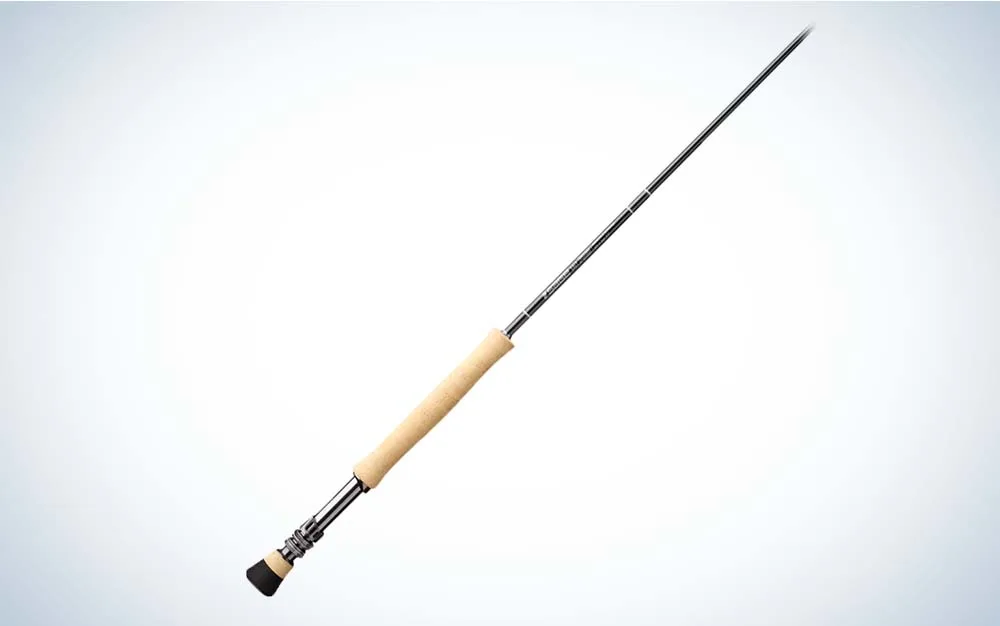
Specs
Line Weight: 8
Length: 9′
Action: Fast
Pieces: 4
Warranty: Sage’s original owner warranty
Pros
Great feel and touch
Extremely versatile for a variety of species and conditions
Strong backbone for big fish
Loads effortlessly
Cons
Expensive
I tested the Sage Salt R8 this past winter during a two-month-long trip to southern Florida. Throughout my time in the Sunshine State, the Salt R8 proved to be one of the best fly rods I’ve ever cast. It loads effortlessly and can throw bombs at cruising fish on the flats. But the Salt R8’s best quality is its ability to make short, accurate casts right off the boat—something many saltwater fly rods fail to do.
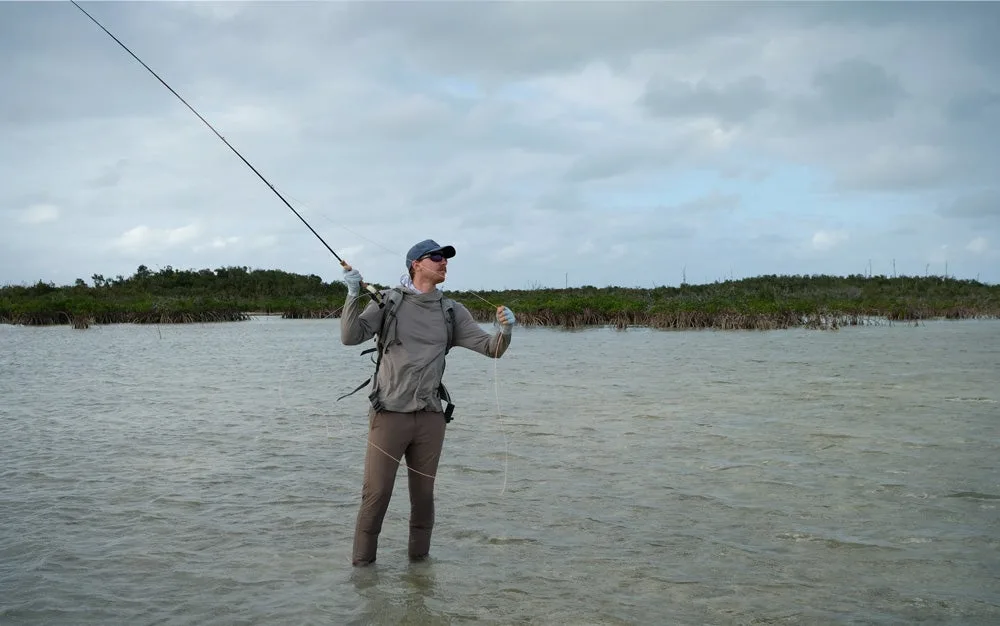
Field & Stream Editor, Ryan Chelius, casts the Sage Salt R8 for bonefish in the Bahamas. Max Inchausti
The R8 was designed with this soft touch in mind. And that’s exactly what separates it from most of the competition—the ability to deliver precise presentations without sacrificing the power and strength needed to handle big saltwater fish. I had no issues punching long casts through 25 mph winds, followed up by dropping delicate presentations to incoming bonefish at 30 feet. The versatility of the R8 is unmatched. Not to mention it has a classic look, a comfortable handle, and durable construction that will make sure it last for years on the flats. And if for some reason the rod doesn’t last season after season, the R8 is covered by Sage’s original owner warranty. —Ryan Chelius
Best Spinning: Penn Carnage III
Best Spinning
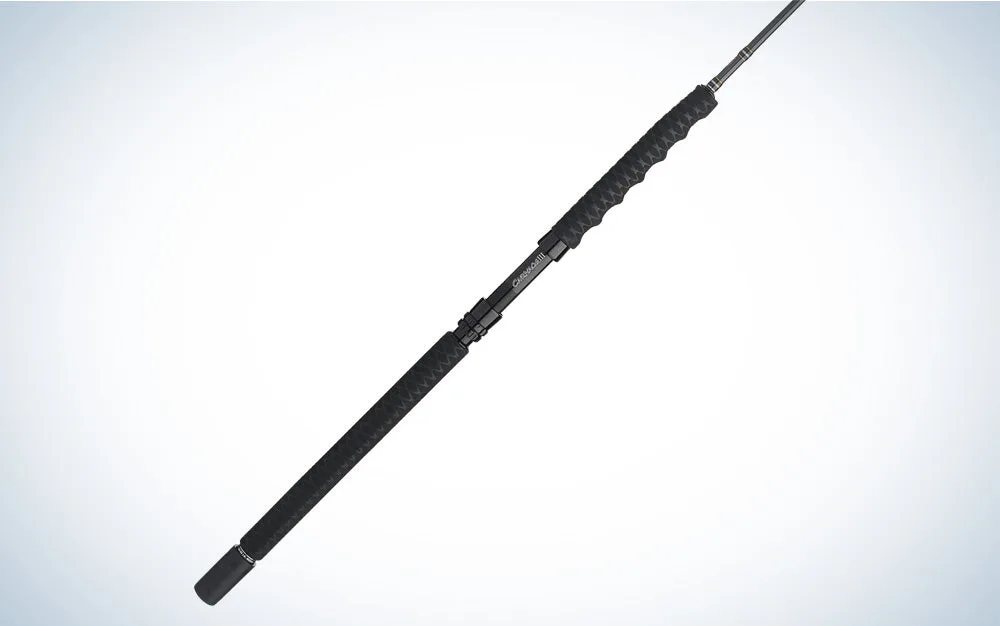
Specs
Lengths: 6’ – 8’
Power: Light through Heavy
Construction: Graphite/fiberglass
Action: Moderate, Moderate Fast
Pros
Versatile options
Heavy duty reel seat
Excellent guides
Cons
Price
I put the Carnage III to the test a couple years ago in Costa Rica and it delivered both inshore and offshore. The first fish I tangled with was a 20-pound Jack Crevalle that gave a highly enjoyable five-minute battle. Although the real test was the next day when I fought a 60-inch, 91-pound yellowfin tuna for approximately 35 minutes on a Carnage III. The guides had anticipated 40 to 50-pound tuna when we first started fishing them, so the rig was slightly undersized for the one that took the bait. And tuna are tough to land on spinning gear regardless. However, the rod’s Fuji K-series guides and aluminum reel seat held admirably through every head shaking, line-peeling moment of that fight. If the Carnage has the backbone for an oversized tuna, it’s tough enough for just about anything that swims.

Field & Stream Staff Writer Travis Smola with the 91-pound yellowfin tuna he caught on the Carnage III in Costa Rica. Photo by Travis Smola
About the only downside I can come up with is that the price tag is on the high side and might be a little much for newer saltwater anglers, especially if you are going to pair it with a comparable reel. We used the Penn Authority on that 91-pound tuna, and that reel starts around the $500 mark. However, given the great ergonomics, and that Penn builds jigging, inshore, surf, slow pitch, and boat variants of these rods, there is nearly something for everyone here. – T.S.
Best Jigging: Bubba Tidal Pro Spinning
Best Jigging

Specs
Lengths: 7’ – 7’ 6”
Power: Medium light, Medium, Medium Heavy
Construction: Graphite
Action: Fast
Pros
Lightweight
Extremely sensitive
Double locking reel seat
Cons
Price tag
Easily scratched grip
Jigging rods require a fast action and great sensitivity, and the Bubba Tidal Pro delivers on both fronts thanks to the all-graphite one-piece construction. Additionally, the double locking reel seat helps hold firm when you hook into a larger fish. Bubba didn’t skimp on this rod, using high quality Fuji K-guides. This is a great option for anglers who like to fish all day because of the light weight afforded by the carbon fiber handle. While this rod excels in jigging inshore, F&S contributor Max Inchausti also regularly took it offshore, where he found it excels in casting too.
Although he also found the grip can scratch easily if you aren’t careful. Our only other downside to this rod is the price tag. This is not a cheap rod, but it’s also not a surprising price considering the graphite construction.
Best Casting Rod: Fenwick HMG Inshore
Best Casting Rod

Specs
Length: 7’
Power: Heavy, Medium, Medium heavy
Construction: Graphite
Action: Fast
Pros
Affordable
Lightweight
High quality guides
Cons
Singe piece is hard to transport
The concept for this rod was very simple, Fenwick took their classic series of freshwater rods and adapted them with newer more durable components for saltwater. The result is a rugged rod that works great in the mangroves, the beach, and just about everywhere in between. Fenwick outfitted this rod with some high-quality Fuji Alconite guides, and a Seaguide graphite reel seat that helps add a ton of value to this rod. Combine all that with a price tag just over $100, and this is a solid fishing rod for beginners and experienced anglers alike. The rod’s fast action gives it a lot of backbone just in case you hook up with something larger like a drum.
The only downside to this graphite rod might be the single piece construction. A 7-foot rod is a bit long for a single piece, which subsequently makes transport a lot more difficult. It might be time to invest in an external rod rack for the vehicle to go with it.
Best Inshore: Star Rod Seagis Inshore
Best Inshore
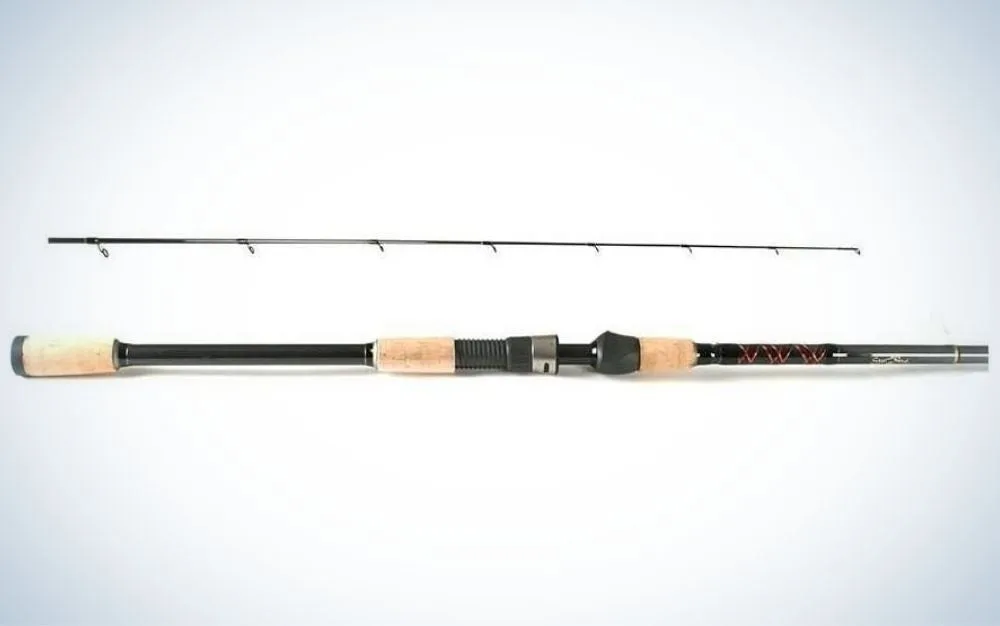
Specs
Lengths: 7’ and 7’ 6”
Power: Medium, Medium light, Medium heavy
Construction: Graphite
Action: Fast
Pros
Lightweight
Quality guides
Highly sensitive
Cons
We wish there were heavier options
For $159, the Seagis is a highly affordable inshore spinning rod for working the flats or mangroves for a variety of species (and would pair well with one of the best inshore spinning reels). This rod is regularly used by F&S contributor Max Inchausti, who found it works great for working big topwater plugs, but still has the versatility to work live baits more slowly. These are a good choice for kayak anglers thanks to the shortened butt section that makes casting easier from a sitting position. However, Star Rods didn’t skimp on the components of this rod, including Fuji K-series guides and a Fuji SK2 reel seat of either split or full cork.
About the only downside to this rod is that the lineup is to a couple of medium heavy actions on the high end. Consequently, it may not be ideal for scenarios where you run into bigger fish.
Best Offshore: Shimano Terez
Best Offshore

Specs
Lengths: 6’ 6” – 7’
Power: Medium through Extra Heavy
Construction: Glass blank
Action: Fast
Pros
Variations for nearly every type of offshore angling
Plenty of backbone for larger species
High quality components
Cons
Might be a little too specialized for regular anglers
Shimano makes a lot of great fishing gear, but the Terez line stands out from the crowd of offshore options. When it comes to versatility, it’s hard to beat the plethora of options available here. Presently there are so many we cannot even list all the different styles, actions, and powers here. However, Shimano has case specific options for trolling, deep-dropping, live bait, and more. The company even makes one specifically for the extra challenge presented by swordfish. Shimano did not skimp on any of the components here either. High-quality Fuji guides and reel seats are the norm, and it’s not surprising these rods run more than $300 depending on the setup.
Because offshore angling presents a whole host of challenges beyond just the rods themselves, some of the Terez line might be too specialized for regular anglers. These rods are common on the decks of the world’s best charter captains. And that’s really the only downside we can come up with on this line. For offshore anglers looking for the best, these are hard to beat.
Best for the Money: Ugly Stik Carbon Inshore
Best for the Money

Specs
Lengths: 6’ 6” – 7’
Power: Medium light, Medium, Medium heavy
Construction: Graphite
Actions: Fast and Extra fast
Pros
Incredible price
Great handles
Great looks
Cons
Heavier options not available
The Ugly Stik Carbon won the best saltwater rod category at ICAST 2022 and subsequently also made our own best fishing gear of 2022 list. This rod is only $100, and is perfect for stripers, snook, redfish, and flounder. There aren’t many other carbon rods with a price point this great. Ugly Stik added stainless steel guides, and the whole rod is made from a single 24-ton graphite blank to bring sensitivity to the setup. A cork fore grip and shrink tube rear handle just add to the ergonomics.
About the only downside to this rod is that we wish there were some slightly heavier options available. However, this is another solid entry-level rod for anyone just getting started in saltwater angling. Additionally, this rod has slick good looks that can be appreciated by anglers of all experience levels.
Best All Around: Penn Ally II Conventional
Best All Around
Specs
Lengths: 6’ and 7’
Power: Medium, Medium heavy, Heavy, and Extra Heavy
Construction: Tubular E-Glass
Action: Moderate fast and Fast
Pros
Extremely durable
Great backbone without sacrificing sensitivity
Sold aluminum reel seat
Cons
Expensive
The Ally II is another rod I got the opportunity to test briefly in Costa Rica and while I didn’t catch many fish with it, the rod still left an impression. While this is primarily an offshore rod, but the smaller versions can transition nicely to some angling inshore too. I caught the first, and so far, only roosterfish of my angling career on this rod. I’ll admit it wasn’t exactly a large fish. In fact, it may be one of the smallest roosters one could catch. But in any case, the rod was quite stout, so I was surprised that I could still feel the smaller fish’s headshakes.
This rod also has excellent ergonomics in the non-slip EVA grips. Penn offers this rod with either Seaguide PVD stainless steel guides or PacBay Roller guides on the heavier models for larger offshore species like tuna. Just like the Carnage III, the only downside to this rod is that it is rather expensive. – T.S.
What to Consider When Buying a Saltwater Fishing Rod
Most saltwater rods have very specific case use scenarios. For instance, surf fishing rods are often found in longer lengths of 10 to 12 feet. The extra length makes these rods easier to cast, especially into the biting, strong winds often present on beaches. Meanwhile, jigging rods are built to be extra sensitive, often using graphite to detect light strikes as the lure is in free fall.
Subsequently, anglers need to pay attention to the type of rod they are purchasing to ensure they are getting the best one for the job. While some rods are versatile enough to make the jump between offshore and inshore styles, others are case-specific for precision casting in the mangroves or tailored specifically towards trolling for billfish.
Multi-Piece Rods and Rod Lengths
Many saltwater rods are now multiple pieces, which makes them easier to transport and to store when not in use. Multi-piece rods also make for good travel fishing rods. However, that portability often comes at the cost of sensitivity. Anglers who demand a more sensitive, one-piece graphite rod must also consider how they will get it to the boat or beach without damaging it.
When it comes to length, most fishing rods for saltwater fall in the 6 to 7-foot range these days. Longer rods tend to only come into play when fishing windy conditions and precision casting is needed. As we’ve already mentioned, the longer rod lengths of 8 feet or more are ideal for surf fishing situations.
Rod Action and Power
It is also important to consider the action of the rod for the style of angling you’ll be doing. When talking about action, most people are referring to the amount of flex a rod has. Fast actions flex only at the tip of the rod and work best for long casting, single hooks, and jigging scenarios. While slow action rods flex significantly from handle to tip and provide better hooksets with trebles. A slow action is usually a good choice for trolling.
Then there are moderate actions that fall somewhere in between fast and slow. These rods can be versatile for more than one style of angling but may take a little trial and error to dial them in just right.
Power is a little more straightforward, and easier to understand. It simply refers to the rod’s stiffness or resistance, and what it takes to make it flex. Light power rods are better for lighter lures, baits, and presentations while heavy rods are better for beefier setups for larger gamefish. Medium powers tend to fall in between these two extremes. These days, there are many subsections of power such as medium heavy, or medium light that seek to bridge the gap between the two actions, giving anglers the best of both worlds.
FAQs
Can any fishing rod be used in saltwater?
Technically you can use any rod in saltwater, but it’s not a good idea. Chiefly because saltwater fish are typically larger, stronger, and require much heavier lines than saltwater fish. Secondly, saltwater corrosion can shorten the life of freshwater gear significantly. Saltwater rods have components specifically designed to combat this problem.
What is the best saltwater rod material?
This depends largely on case use scenario and personal preference although the two most popular are fiberglass and graphite. Although fiberglass rods are more durable and affordable, they are also not as sensitive as a graphite rod. While graphite provides more ability to detect light strikes, it’s also more prone to breaking, and significantly more expensive. Many rod companies now build composite rods that are a blend of both materials. For durability, go with fiberglass, for precision angling and strike detection, go with graphite.
What weight rod is best for saltwater?
When it comes to fly fishing, choosing the right weight rod can be challenging. Most anglers prefer to use at least an 8-weight rod. While considered somewhat light, some like to drop down to a 6 or 7-weight for popular species like bonefish and redfish. For harder-fighting, larger fish like tarpon, a 10 to 12-weight rod is a better choice.
Final Thoughts on the Best Saltwater Rods
Best Rod and Reel Combo: Daiwa BG Saltwater Combo
Best Fly Rod: Sage Salt R8
Best Spinning: Penn Carnage III
Best Jigging: Bubba Tidal Pro Spinning
Best Casting Rod: Fenwick HMG Inshore
Best Inshore: Star Rods Seagis Inshore
Best Offshore: Shimano Terez
Best for the Money: Ugly Stik Carbon Inshore
Best All Around: Penn Ally II Conventional
Saltwater rod technology is really at a pinnacle presently. There are so many great options out there for anglers both new and seasoned. The Sage Salt R8 and Carnage III are two of our favorites based simply on the versatility and the awesome backbone both have proven to us during on the water testing. However, any of the best saltwater rods on this list is a great choice for your next angling adventure on the ocean.
Why Trust Us
For more than 125 years, Field & Stream has been providing readers with honest and authentic coverage of outdoor gear. Our writers and editors eat, sleep, and breathe the outdoors, and that passion comes through in our product reviews. You can count on F&S to keep you up to date on the best new gear. And when we write about a product—whether it’s a bass lure or a backpack—we cover the good and the bad, so you know exactly what to expect before you decide to make a purchase.


